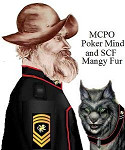McGuiness wrote:
With my luck he's referring to the next book in the Honorverse, which wouldn't hurt my feelings either. The fact that "Hell's Gate" is being published in July means that the clock is ticking on the release of the "The Road to Hell," so RFC has to write his half and edit the entire novel sometime in the next few months, if he isn't editing it now.
Over on the Multiverse forum on April 27th Joelle Presby wrote
Himself (aka RunsWithCelery) has sent me the *full* draft. I'm excited. Soon, I hope very soon, we'll be sending the manuscript to Baen.
We have a tentative publication slot of March 2016 for THE ROAD TO HELL.
http://forums.davidweber.net/viewtopic.php?f=6&t=6132&start=20#p189731
Suggests that RFC's big push has been on this. (Back in October he was talking about maybe getting it finished by the end of 2014!)










 and, Mangy Fur the Smart Alick Spacecat.
and, Mangy Fur the Smart Alick Spacecat.